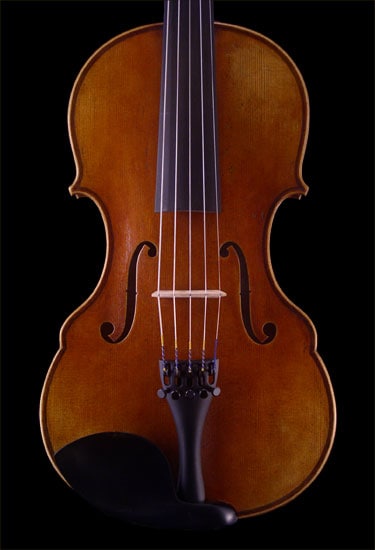designed for the highly trained player who can focus and control the power of this new model
Okay...really? Plus the "new model" is something like 15 years old, and externally at least the only difference is that it's a whole lot less ugly: here's a 2007 model, and the finish is sort of meh, and it has that funky non-traditional scroll that I assume is easier and cheaper to carve. But not mine!
I'm not 100% sure I understand the drive towards beauty in instruments. The saying goes "It should make you want to pick it up and play," and that's ultimately a shallow, aesthetic impulse. As far as I know, that striping ("curl") of the maple back and neck doesn't affect the sound: those pieces rely on uniform density and strength to do their job. Violin makers judge wood primarily by tapping it to see what sound it makes, and then secondarily by how pretty it is, because that's just what players expect.
Does the varnish matter? It's not controversial that coating the wood in the wrong material will affect the tone: imagine encasing all these vibrating parts in something rigid like epoxy. You want it to protect the wood, which often means filling in the pores, which should be constricted anyway by letting the wood dry-cure for as long as you can stand, but maybe some of the porosity is involved in giving the wood the flex to vibrate... Applying non-invasive technology to the good instruments of any age, we're learning what makes them tick, and notwithstanding our recurring belief in a lost Golden Age (of anything), modern makers can build you an instrument that will stand toe-to-toe with a Stradivarius or a Guarneri, for $50,000 instead of $50 million.
You see how the finish is a lighter color in spots? That's antiquing to make the instrument look older than it is, a practice about as old as the expensive violins themselves. For the most part, it's not fooling anybody.
Years ago, NPR did an interview with the sound engineer at BMW who was in charge of how a BMW's door sounds and feels when you shut it. It's a recognition that our experience of an object goes far beyond its function. Consciously or not, you can tell when a door has been thought through down to small details, and that sets us up to expect a similar depth of thought in the driving experience, which hopefully the car can deliver on. And, of course, it looks pretty.
The instrument and I are still getting warmed up, but it's a keeper. I don't qualify as "highly trained" yet, and it is definitely a more advanced instrument, every bit as particular and demanding and rewarding as my reading has led me to expect.
It's not something I would have shopped for, but I have been hoping my next keeper violin would have a stripey neck.
The sound from the internal pickup really is amazing, too.
This is fun.






